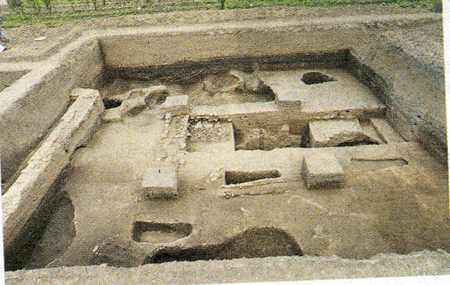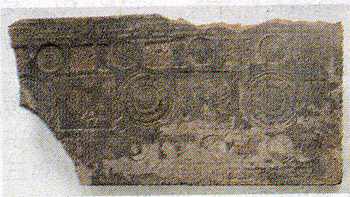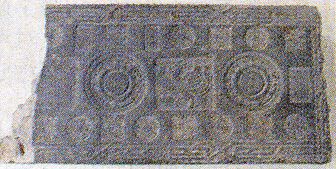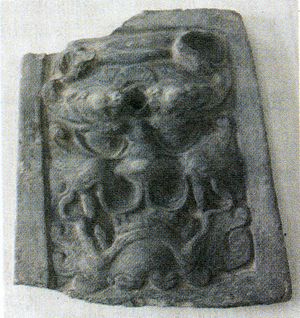New discoveries of 2012 excavation to the Jinyang ancient city-site in Taiyuan
From:Chinese Archaeology NetWriter:Date:2013-11-15
The Jinyang ancient city-site, one of the National Key Cultural Heritage Sites, is located at the Jinyuan District in Taiyuan, Shanxi Province. From middle February to late May 2012, incorporating with the construction of National Archaeological Site Park, the Shanxi Provincial Institute of Archaeology has conducted a small-scaled excavation to the site. The excavated area lies 200 m south of the Guchengying Village. Totally 9 square units each 5*5 meters covering an area of 225 square meters have been uncovered.
Although in a small scale, the excavation reveals a clear sequence of layers from Northern Dynasty to the modern period. There are totally 17 remains of various kinds, including 12 ash pits, 1 water tank, 1 section of road with carriage tracks, 1 tomb, 1 kiln and 1 house foundation.

Excavated area of ancient Jinyang city
The house foundation F1, which is seriously destroyed, belongs to Tang Dynasty. Only part of its south wall, the partition wall in south-north direction and parts of the brick-paved floor are uncovered, therefore the structure and function remain uncertain. But it is of great significance for studying the city’s layout and architectures of Jinyang in Sui-Tang Dynasties.
The excavation yields an important building from Northern Dynasty, which could be a storehouse. It is in round shape, and wood planks and beams in good state of preservation could be seen. Buried objects, although in a small number, cover a wide time range from Northern Dynasty to Ming and Qing dynasties. Objects from Sui and Tang period have a big proportion. Besides the building materials and daily-used pottery, ceramics, there are bronze objects like Wuzhu coins, Kaiyuan Tongbao coins, Qianyuan Tongbao coins, arrow heads, balls and nails. Iron-wares include tube-like objects and cubic objects. There are bone objects such as hairpins and combs and stone objects like discus-shaped objects and pedestals. The other materials are from Northern Dynasty and Song and Yuan Dynasties. Most pottery and ceramics serving for daily use are remains from Northern Dynasty, Sui and Tang periods. Some of them belong to Song to Qing dynasties. Building materials are mainly tile ends and bricks. A gray clay ridge-end tile has been found, which has a trapezoid shape with the top narrower than the bottom. Its front is caved with a beast head in relief, with a hole between the eyebrows. Such kind of beast head design, if in low relief, could be from Northern Dynasty. Among the building materials the most important findings are two components with inscriptions reading “Da Wei Xinghe ernian zao”(made in the second year of Xinghe reign of the great Wei) and “Da Qi Tianbao yuannian zao”(made in the first year of Tianbao reign of the great Qi), that is, 540 AD and 550 AD respectively. Such kind of inscribed building components have not been seen so far, and the combination of locus design with design of a creature with a beast head, a bird body and horse feet is also very rare in Northern Dynasty, which appears only in wall paintings of some tombs like Xu Xianxiu’s tomb, Lou Rui’s tomb and Wanzhang Northern Dynasty tombs. The lotus and honeysuckle designs are typical patterns of the period. The two building materials have same shapes, sizes and decorations, and only ten years of time difference, showing that the existence of large-sized architecture in the city-site, and the building in question have been repaired at least two times.


unearthed architecture parts from Jinyang ancient city
It is notable that the excavating area could provide clues for figuring out the layout of ancient Jinyang. To the northwest of the city is the famous Xishan Buddha Carving of Taiyuan. According to documents, the excavating area should be the palace where Gao Huan resided to build the statue. Judged from the inscribed building materials, the Jinyang Palace could be set up on the basis of the great premier’s mansion.

unearthed architecture parts from Jinyang ancient city
The excavation not only reveals strata proving that the city has been flooded at the beginning of Song Dynasty, but also yields remains from different dynasties, which provides new materials for studying the change of ancient Jinyang from Northern Dynasty down to Ming and Qing dynasties. The most important is that the inscribed building components and the round building remain are very valuable for better understanding the city’s layout and planning during Northern Dynasty to Sui and Tang dynasties. Moreover, the excavation supplies a reference and a clear direction for future’s archaeological work in the ancient Jinyang city-site. (Translator: Tong Tao)

